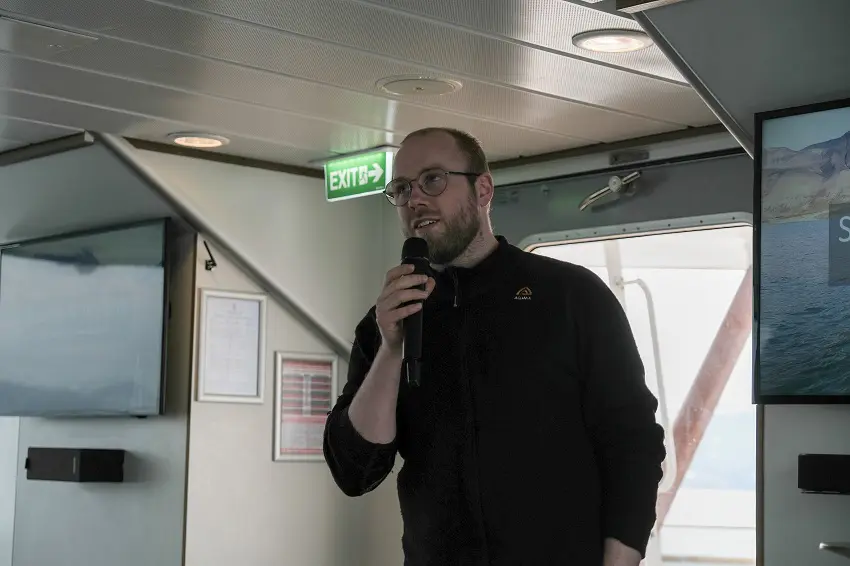Science communication with a view
A cooperation between the tourist vessel MS Bard and UNIS gives students a unique opportunity to practice their science communication skills. For the guests onboard it is a fantastic way to learn more about the research in the pristine location they visit during their holiday.

The guests on board Bard got a great insight into the mudflats of Adventfjorden and Arctic fjord microbiology. Photo: Maria Philippa Rossi
Text: Maria Philippa Rossi
It is early o’clock on a Monday morning in June. Last month’s temperature records are long gone, it is a chilling 3 degrees Celsius, but no wind. Seventeen guests board the hybrid catamaran, currently docking at an overcrowded pier.
– I think we are all then! Karoline Viberg says.
She is the content responsible at Brim Explorer and an eager science communicator.
– The reason we wanted to cooperate with UNIS was to help communicate all the exciting knowledge there is in Svalbard. There is a lot of information that tourists never get introduced to.
UNIS students can sign up for boat trips all summer and give a talk about their research and studies in Svalbard.
– We see that our guests are eager to acquire knowledge about the places they visit. It is then our duty to make sure the information they obtain is correct, and to cooperate with the university centre is a good starting point. The talks also teach our guides new things, and it is important to keep them curious as well, Viberg says.
Living laboratory
Just in front of the massive windows on the upper deck on Bard, two students have settled down comfortably for the day.

Sebastian Junker Andersen, originally from Denmark, now doing a master at the University of Tromsø, gets up in front of the small crowd. In 15 minutes, he will give a brief and condensed version of two years of studying.
– At least that is what I will try to do, he laughs.
Andersen masters it brilliantly. The guests and crew are given a great insight into the Arctic fjord microbiology. The Arctic food chain consists of species of algae, zooplankton, fish, birds, whales, seals, and polar bears.
One light to rule them all
Life in the Arctic is challenging for all living things, especially due to the demanding light conditions. The sun is below the horizon for 1/3 of the year, never sets for 1/3 of the year, with only brief transition periods of days and nights in between. Furthermore, due to the shallow sun angle, the ground or water heats up very slowly – despite the midnight sun.
From an algae perspective, this causes some different challenges.
– During winter there is no light, but a high level of nutrients, but no growth. In spring there is lots of light, high nutrients, and high growth. In the summer, there is plenty of light, but the nutrient level in the water is on the decline, Andersen explains.
And here is Andersen’ studies come to its right: because muddy melt water is important.
– It resupplies the water with nutrient from the land. Riverine nutrients boost growth by 10 – 300 times compared to that of the fjord. The riverine water can really support life during summer, he says.
Fifteen minutes is too short. We want to learn more about this, but the scenery awaits!

Get your hands dirty
Just as Andersen finishes talking about nutrient boosts, Bard reaches the impressive glacier front of Nordenskiöldbreen. A bearded seal on an ice floe is ignorant to the catamaran, who for the occasion, has turned on its electric engines and glides silently through the water.
After a short stop in front of the glacier it is time to head back to town. Eleanor Handler is in charge of the science communication on the return trip and introduces the tourists to the mudflats in Adventfjorden.
Mudflats may not sound like the hottest of topics, but Handler’s enthusiasm makes you want to listen. And it is a good story! She tells of the nitty gritty processes of doing fieldwork in the intertidal area – an area of the delta most researchers before her have skipped because of its inaccessibility.

– After getting several warning emails about how difficult it would be to access the area, we ended up building a homemade kayak catamaran, which was perfect for the job, she says.
As Bard docks back at the pier, a new group of tourists are getting ready for an adventure on Isfjorden. Hopefully, they will return home with more knowledge of the pristine, but vulnerable location they chose for their holiday destination. And they sure will never look at muddy water the same way again.
– To get the chance to reach people we normally do not target with our research is instructive. It is a part of the learning experience to be able to communicate what we study in a popular scientific way, Andersen concludes.
